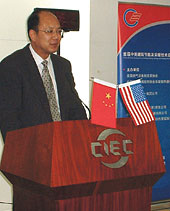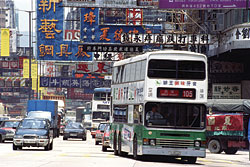Approximately one year ago, the association responded. And, make that loud and clear.
On August 1, 2004, GAMA answered its members' pleas by officially opening a joint office with the National Electrical Mechanical Association (NEMA). The GAMA-NEMA joint office in Beijing is dedicated to assisting its members navigate China's booming economy.
The region, once commonly known as the Sleeping Tiger, is more aptly called the Hungry Tiger in the vernacular of today's global economy. Its seemingly insatiable appetite for steel, energy, and other raw materials needed to build a growing infrastructure has left a trail of perplexed and sometimes perturbed onlookers.
Case in point: The U.S. steel industry's woes have been compounded by the ravenous demand in China and other Pacific Rim nations. The international demand for steel shows no sign of abating, while manufacturers' announcements of price increases continue with regularity.
Some gas, electric, oil, and boiler manufacturers and other HVAC manufacturing companies have been conducting sales and marketing efforts in China for decades. Some of those have well-established production facilities in the country. Still, there are those that only began recently to seek business relations or new operations in the burgeoning Chinese market.
Heightened expectation of increased opportunities, by GAMA and its members, is but one reason for an interest in strengthening business relations in the Asian country.
Technology solutions and joint ventures are highly valued by the Chinese. A GAMA visit in November 2004 provided opportunities for staff members to explore business relationships with various Chinese agencies and ministries. The trip provided a backdrop for meetings so that GAMA staff could meet with specialists on subjects ranging from product standardization to trade issues, as well as investment opportunities.
Business History
The United States is a major exporter of air conditioning equipment to China, which has an estimated population of nearly 1.3 billion. China is now America's third-largest export market for general HVACR products, having reached the $300 million mark in 2001, according to the U. S. Commerce Department. Specific statistics for space heating and water heating gas, electric, oil and boiler products are not yet available.However, indications are that this market segment will also hold a lot opportunity for U.S. manufacturers.
For example: boilers and pressure vessels represent a huge export business to China. There are 700 boiler exporters to China around the world, 100 of which are U.S. manufacturers.
As the Chinese economic infrastructure continues its rapid expansion, commercial and residential construction growth indicates tremendous potential for U.S. manufacturers of space heating and water heating products, and components and parts.
Most U.S. manufacturers that build space and water heating gas products in China do so for local consumption in that country. Some people express concerns about various forms of a Chinese invasion of HVAC products.
One scenario suggests that Chinese-American ventures could build product in China and ship back to the United States. Another, that Chinese-owned businesses could do the same.
However, just as the Japanese car manufacturers found in the early 1970s, transportation costs usually outweigh any low-cost production savings - shipping finished HVAC products across the Pacific Ocean isn't yet practical, and related energy costs don't appear to be headed in a direction that would change this situation.
Of course, many components being built in China, and other countries, often find their way into products assembled in the United States.

The Coalition's Goals
Michael Blevins, director of government affairs and communications for GAMA, said the harmonization of standards is the No. 1 priority for the GAMA China Coalition."We want China to recognize and use our standards. Currently, the country really has no standards for many of its own products," said Blevins, who also noted that the GAMA-led effort for the United States is slightly behind the European community.
"We are competing with the European community that has been making a strong play to have the Chinese adopt their standards. The Europeans have been there longer with their lobbyist efforts, so we have our work cut out for us."
The early Chinese standardization system was adopted from the Soviet model. Then, it changed to the Japanese system about 20 years ago. The current system has four levels: national, industrial, local, and enterprise. The national, industrial, and local standards are distinguished as either compulsory or voluntary.
This system is currently under reform. According to the Ministry of Construction, by the end of next year, local standards will be cancelled, all standards will become voluntary, and parts of current compulsory standards will become technical codes.
If this seems to be in a state of flux, that's only the beginning. For the industries represented by GAMA, the Ministry of Construction and Bureau of Safety Supervision of Special Equipment are but two of the 72 organizations in China that GAMA should work with on standards compliance.
Another big issue facing GAMA members is the counterfeiting of products in China.
"Intellectual property rights (IPR) have been a point of contention in China for many years," said Blevins. "One of our major goals is to get on the same page with Chinese government officials who are trying to curb the problem in their own country."
The counterfeiting of products is not only a problem for manufacturers in other countries, but also for China. Counterfeiting is increasingly severe in the country. Five percent to 20 percent of goods in the local markets are not genuine, affecting virtually all industry sectors. Also, China is the source of 60 percent of European and U.S. Customs seizures.
Some estimates put Chinese counterfeiters' contribution to the problem at two-thirds of all fake goods that show up in the global market. On the other hand, the quality of the counterfeits is increasing, and infringers are going underground and becoming more sophisticated.
In the past five years, China has been gradually building up its IPR protection system. The Intellectual Property Rights Protection Seminar, co-sponsored by GAMA, was held in Beijing Convention Center on March 2 of this year.
The purpose of the seminar was to examine the Chinese legal system and the mechanisms that the Chinese government uses to catch and incapacitate counterfeiters, and then to develop a strategy that manufacturers can use to help Beijing put counterfeiters out of business.
This seminar, which was chaired by Shanlin Wen, the director of the GAMA office in Beijing, included three presentations: "Anti-counterfeiting Products Network," "IPR Protection in China," and "How We Fight With Counterfeiting Products Through Administrative Channel."
In many anti-counterfeiting cases, it is surprising that most infringers have close relationships with the infringed companies: distributors, former employees, current employees' relatives, etc.
The problem is that those infringed companies usually have their headquarters overseas, outside of China, and don't have experiences in adjusting their cooperative management to the Chinese regulatory system. For example, they need to strengthen their Western filing patterns due to the current incomplete legal system in China.
Secondly, companies usually do not recognize the importance of patent application until they find counterfeiting goods in the market. It is too late to do anything once the counterfeited goods are accepted in the market. It is suggested that a manufacturer quickly update the infringed product and immediately apply for patent protection for the new model.
A third method for battling IPR infringement is to establish self-regulation in the particular market. For example, considering the damage of counterfeiting products to electrical equipment manufacturers, China Electrical Equipment Industry Association (CEEIA) established the Anti-Counterfeit Alliance in 2002. This alliance has cooperated with the Chinese agency, Office of Anti-Counterfeiting Products, and tackled many counterfeiting goods cases.
Generally, the goal of GAMA with regard to IPR is to keep a close eye on the situation, being proactive in the interests of member companies.

Recent Efforts in China
Another purpose behind the GAMA China Coalition is to promote U.S. products, technologies, and the interests of members themselves."We identify those agencies and ministries in China that are appropriate to our industries," said Blevins.
"We want to make sure that our Beijing representative becomes known as a resource for the Chinese government to find out more about U.S. products and technologies, and how to best use these in China. If our members need any help at all with their visits to China, we want to have the answers they need."
"I am pleased that GAMA has an office in Beijing now to assist our members," added Evan Gaddis, GAMA president. "Having someone on the ground, in Beijing, to liaise with the appropriate Chinese governmental offices, will help address issues and implement strategies to resolve them. GAMA doesn't only identify problems. Now we are willing and able to do some of the heavy lifting."
The Beijing office now has three full-time staffers dedicated to serving the members of the coalition. Office director Wen is a retired Chinese government official, Zhou Liying is the GAMA representative, and NEMA has a person advocating for the electrical group. Their job is to work for GAMA and NEMA members who have an interest in China.
"In 10 months we have a lot accomplished," said Blevins. "We participated in the U.S. China Standards and Conformity Assessment Workshop, which was jointly sponsored by the U.S. Chamber of Commerce and the Chinese government. Frank Stanonik, GAMA's chief technical person, made several presentations during the workshop,"
In addition, GAMA co-sponsored the first symposium on Building Energy Savings and Heating Technology Application in Beijing on March 9 of this year. Other sponsors included the China Radiation Commission and the International Copper Association.
It was held in conjunction with the Fifth China International Heating and Air Conditioning Product and Technology Expo. About 140 advanced designers a nd engineers in the heating and radiant heating industry in China presented at the seminar.
Five presentations were available to attendees: "American Heating Systems History - the Present and the Future," by Ken Secor, GAMA I=B=R school instructor; "Water Quality & Radiator Application in Chinese Hydronic Heating System," by Mu Lingquan, deputy director of China Radiant Commission; "Central Heating Technology in Major American Industrial/Commercial Buildings," by Tom Smith, Hydro-Air Components; "Introduction of U.S. Standards for Water Heaters and Boilers," by Shawn Pan, A.O. Smith (China) Water Heater Co.; and "Copper Radiator Applications," by Bob Tian, project manager of International Copper Association.
In an effort to influence Chinese standards, GAMA has embarked on an interesting task. The Chinese gas appliance industry is just beginning the process of writing its own fuel gas code.
NFPA54 is the U.S. National Fuel Gas Code. GAMA is translating that into Chinese and suggesting that it be used as a guide by the Chinese. (The Chinese translation was scheduled to be completed by the end of July.)
Globalization may be viewed as an often overused word in this new century of free trade and growing economies. Still, it is appropriate in the world in which we live now. One in which the industries of the United States must think, not only outside of the box, but outside of the traditional borders.
The GAMA China Coalition is self-supporting: the dues are over and above normal membership in the GAMA organization. The coalition is open to all GAMA members. There are currently 30 participating companies. For more information on membership in the China GAMA Coalition, contact Michael Blevins, 703-525-7060, ext. 235.
Publication date: 08/15/2005

Report Abusive Comment